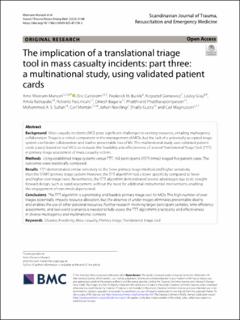| dc.contributor.author | Khorram-Manesh, Amir | |
| dc.contributor.author | Carlström, Eric | |
| dc.contributor.author | Burkle, Frederick M. | |
| dc.contributor.author | Goniewicz, Krzysztof | |
| dc.contributor.author | Gray, Lesley | |
| dc.contributor.author | Ratnayake, Amila | |
| dc.contributor.author | Faccincani, Roberto | |
| dc.contributor.author | Bagaria, Dinesh | |
| dc.contributor.author | Phattharapornjaroen, Phatthranit | |
| dc.contributor.author | Sultan, Mohammed A. S. | |
| dc.contributor.author | Montán, Carl | |
| dc.contributor.author | Nordling, Johan | |
| dc.contributor.author | Gupta, Shailly | |
| dc.contributor.author | Magnusson, Carl | |
| dc.date.accessioned | 2024-03-21T09:45:22Z | |
| dc.date.available | 2024-03-21T09:45:22Z | |
| dc.date.created | 2023-12-18T14:42:58Z | |
| dc.date.issued | 2023 | |
| dc.identifier.citation | Khorram-Manesh, A., Carlström, E., Burkle, F. M., Goniewicz, K., Gray, L., Ratnayake, A., Faccincani, R., Bagaria, D., Phattharapornjaroen, P., Sultan, M. A. S., Montán, C., Nordling, J., Gupta, S., & Magnusson, C. (2023). The implication of a translational triage tool in mass casualty incidents: part three: a multinational study, using validated patient cards. Scandinavian Journal of Trauma, Resuscitation and Emergency Medicine, 31(1), Artikkel 88. | en_US |
| dc.identifier.issn | 1757-7241 | |
| dc.identifier.uri | https://hdl.handle.net/11250/3123566 | |
| dc.description.abstract | Background: Mass casualty incidents (MCI) pose significant challenges to existing resources, entailing multiagency collaboration. Triage is a critical component in the management of MCIs, but the lack of a universally accepted triage system can hinder collaboration and lead to preventable loss of life. This multinational study uses validated patient cards (cases) based on real MCIs to evaluate the feasibility and effectiveness of a novel Translational Triage Tool (TTT) in primary triage assessment of mass casualty victims.
Methods: Using established triage systems versus TTT, 163 participants (1575 times) triaged five patient cases. The outcomes were statistically compared.
Results: TTT demonstrated similar sensitivity to the Sieve primary triage method and higher sensitivity than the START primary triage system. However, the TTT algorithm had a lower specificity compared to Sieve and higher over-triage rates. Nevertheless, the TTT algorithm demonstrated several advantages due to its straightforward design, such as rapid assessment, without the need for additional instrumental interventions, enabling the engagement of non-medical personnel.
Conclusions: The TTT algorithm is a promising and feasible primary triage tool for MCIs. The high number of over-triages potentially impacts resource allocation, but the absence of under-triages eliminates preventable deaths and enables the use of other personal resources. Further research involving larger participant samples, time efficiency assessments, and real-world scenarios is needed to fully assess the TTT algorithm's practicality and effectiveness in diverse multiagency and multinational contexts. | en_US |
| dc.language.iso | eng | en_US |
| dc.rights | Navngivelse 4.0 Internasjonal | * |
| dc.rights.uri | http://creativecommons.org/licenses/by/4.0/deed.no | * |
| dc.title | The implication of a translational triage tool in mass casualty incidents: part three: a multinational study, using validated patient cards | en_US |
| dc.type | Peer reviewed | en_US |
| dc.type | Journal article | en_US |
| dc.description.version | publishedVersion | en_US |
| dc.rights.holder | © The Author(s) 2023. | en_US |
| dc.source.volume | 31 | en_US |
| dc.source.journal | Scandinavian Journal of Trauma, Resuscitation and Emergency Medicine | en_US |
| dc.source.issue | 1 | en_US |
| dc.identifier.doi | https://doi.org/10.1186/s13049-023-01128-3 | |
| dc.identifier.cristin | 2215014 | |
| dc.source.articlenumber | 88 | en_US |
| cristin.ispublished | true | |
| cristin.fulltext | original | |
| cristin.qualitycode | 1 | |

